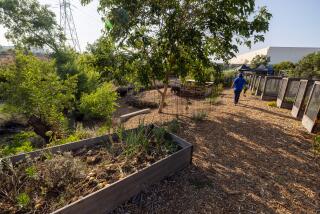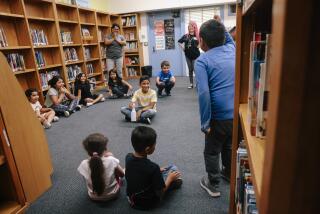Learning ABCs of Teaching : Training: Program gives new instructors the opportunity to gain from the experiences of their colleagues.
- Share via
Sue Cirillo was putting up decorations in her first-grade classroom the day before school started, preparing for her first day as a teacher.
Unexpectedly, her principal came in and told her that there would be some changes. Her new students would now be first- and second-graders, and some would speak only a little English. Besides that, she would be teaching on a different track, meaning that her vacation time would be changed.
Cirillo turned to the one other person in the room: Marion Schumacher, a 71-year-old retired teacher from Canoga Park who was helping her as part of a state pilot program to get new teachers off to a good start. They began moving everything to another classroom, where Cirillo hung the decorations while Schumacher went to the library to pick out books for the class. Before she left, Schumacher suggested some activities for the first day of school.
“As a new teacher, I was near tears. She said she would get me through it,” said Cirillo, 28, who is now in her second year of teaching. “It was overwhelming. I don’t know if I would have stuck it out if it weren’t for her help. I’ve had friends who were not part of this program and they weren’t able to make it.”
Cirillo is one of more than 3,800 new teachers who have received help from the California New Teacher Project since it started statewide in 1988. The project includes 37 different programs involving school districts, county offices, universities and teachers organizations. The program was established to help people make the transition into teaching, not to make up for any shortcomings they may have.
Cal State Northridge’s program, which began two years ago, has helped 108 beginning teachers and involves officials of the Los Angeles Unified School District and United Teachers-Los Angeles. Students who receive their teaching credential through CSUN and who are hired by L. A. Unified to teach kindergarten through sixth grade in the San Fernando Valley are invited to apply to participate. About 35 per semester will be placed. Those who cannot be placed because of space considerations are sometimes referred to other, less formal sources of help.
CSUN program participants are linked with recently retired teachers who provide pointers on many aspects of the profession, from getting the children’s attention to dealing with difficult parents. The teachers are also paired with a colleague on campus--a “buddy teacher”--who can help with school-related problems, and they are visited by the university professor under whom they did their student teaching.
Occasionally, the new teachers are allowed to take a day off to attend workshops or observe respected teachers in the classroom. A substitute, paid for by the New Teacher Project, covers for the novice, who receives normal pay.
This school year, the CSUN program was opened to bilingual teachers who have emergency credentials and are taking education classes at CSUN.
Even though student teaching provides practice, no new teacher can be fully prepared for the reality of facing a classroom solo, education officials say.
“From the very first day, they are given the same kind of an assignment as a veteran teacher of, say, 30 years,” said Susan A. Wasserman, director of CSUN’s new teacher program. “You really can’t tell the difference in terms of the time and effort they have to put in.”
One goal of the program is to keep new teachers in the classroom.
The U. S. Department of Education’s National Center for Educational Statistics studied a group of teachers from 1977 to 1986 and found that 37% of them left the profession in the first five years. A local comparison is unavailable since CSUN does not track teachers who were trained at the university.
Although the California New Teacher Project has existed for only three years, education officials believe that it is helping teacher retention. They point to the fact that every new teacher who has gone through the program at CSUN is still teaching, and that only 2% of those who have participated statewide have left the profession.
Based on regular studies by Southwest Regional Laboratory, an independent evaluator that the state hired, state officials say participating teachers had better planning practices, gave more learning opportunities to their students and generally provided a higher quality of teaching.
The state Commission on Teacher Credentialing and the California Department of Education will present a report in March to the Legislature and Gov. Pete Wilson detailing the methods and results of the different projects.
“We’ve proven that support makes a difference,” said Sue Garmston, consultant for the state Department of Education’s instructional services and teaching support division. “New teachers are better equipped and more satisfied with being a teacher.”
Hoping to see the program expand to all beginning teachers in California, state officials have already requested $22 million for the 1992-93 school year. The governor has included $10 million for new teacher support in his proposed budget. Exactly how that money would be spent, if it is approved, has not been decided.
Competition for state funding will be tough, but Garmston said the timing of the March report should help state officials see the importance of helping new teachers.
“I think that we have a chance,” she said. “It’s a strong statement on the part of the governor that he put $10 million for new teachers in his budget.”
If state funding is not approved, CSUN officials said they will seek grants from businesses and foundations, and possibly federal funding, to maintain the local program.
A total of $260,000 was allocated for the CSUN pilot project, money that in part pays for stipends for the new teachers, retired teachers, buddy teachers and university professors, in addition to providing the substitute teachers to cover on workshop days. All of the funds come from the state, although the university, school district and teachers union contribute supplies, workshop meeting places and some staff time.
New teachers who participate in the program receive up to $150 for classroom materials, and buddy teachers get a $150 stipend. Retired teachers receive $1,200 for 20 visits, and university teachers receive a total of $240 for four visits.
Besides the California New Teacher Project, beginning teachers receive assistance from CSUN’s privately funded Help-Line program, which offers teacher workshops and links new teachers with a variety of advisers, sometimes over the phone. L. A. Unified also supports new teachers through a less intense mentor-teacher program.
Sandy Allman, 32, who started teaching at Fullbright Avenue School in Canoga Park in August, is one beginner who thinks that she has benefited from participating in CSUN’s New Teacher Project.
Through suggestion and example, retired teacher Flo Truitt gives Allman ideas picked up during 30 years of teaching. Truitt has helped her slow down when presenting new lessons to her combined first- and second-grade class so that pupils will better comprehend the information. Truitt also acts as a library of sorts, providing copies of materials she acquired during her career.
“She keys in on my weak points. It’s never criticizing. She gives positive suggestions to make it better,” said Allman, who is one of 35 current CSUN participants.
Truitt, 64, of Van Nuys, says she empathizes with new teachers. In her first year of teaching, she asked her first-grade pupils to bring a Valentine for each of their 40 classmates. But she left only 15 minutes to pass out the cards, never having stopped to calculate that there would be 1,600 heartfelt sentiments to deliver.
“I know what the first year is like. Teachers are lucky to have the kind of support they get from this program,” she said.
Janet Chin, who teaches kindergarten at Fullbright, serves as Allman’s on-campus buddy teacher, providing her with inside information on such matters as school paperwork. And she occasionally takes half of Allman’s class to her classroom to work on phonics or to paint. That enables Allman to teach grade-specific lessons to either her first- or second-graders.
And then there are the occasional visits from Allman’s university professor.
“I’m inundated with help, which is great,” Allman said. “It used to be that new teachers got hired and it was sink or swim.”
Jim Grover, principal at Fullbright, said both of the new teachers at his school who have participated in the project have been helped by it.
“It’s a bridge they need to really be successful,” he said.
Even people who have had some teaching experience have been helped.
Ramon Olivera recently came to the United States from Mexico and started teaching elementary school in February, 1991. Although he taught psychology and social studies at the National University of Mexico, he was not prepared for his experiences with young children. He joined CSUN’s program in July.
“At the beginning, when I wasn’t in the program, it wasn’t so easy,” said Olivera, 51. “Now, I feel confident. I can’t tell you the difference the program has made.”
Wasserman, director of the program at CSUN, said: “These are competent people who want to do the best job possible for the children in their classrooms, and they want to perfect their performance to the point where every child will learn to their best capability. By giving them the support at the beginning, they will be those outstanding educators who really touch the lives of children.”
More to Read
Sign up for Essential California
The most important California stories and recommendations in your inbox every morning.
You may occasionally receive promotional content from the Los Angeles Times.










